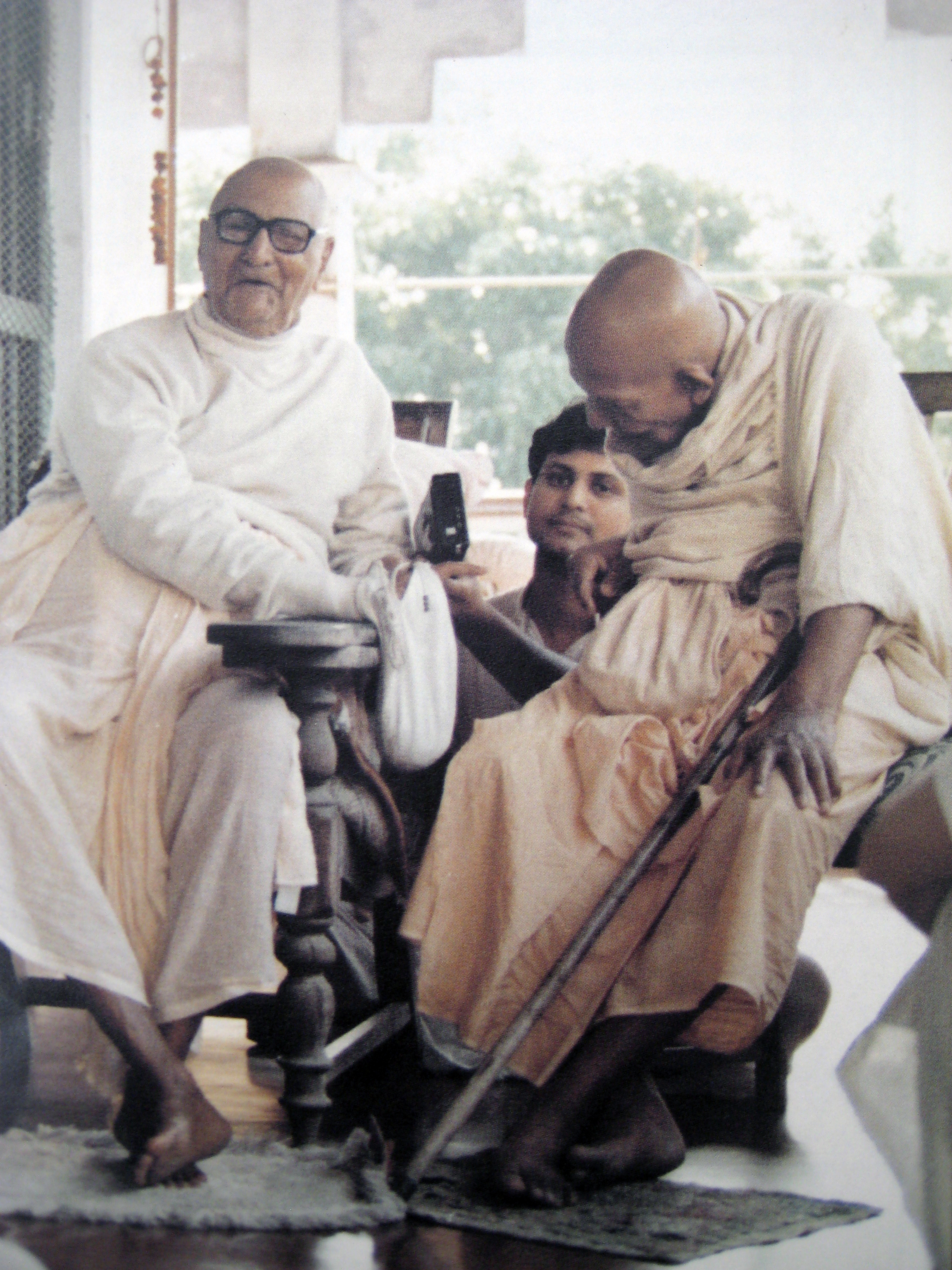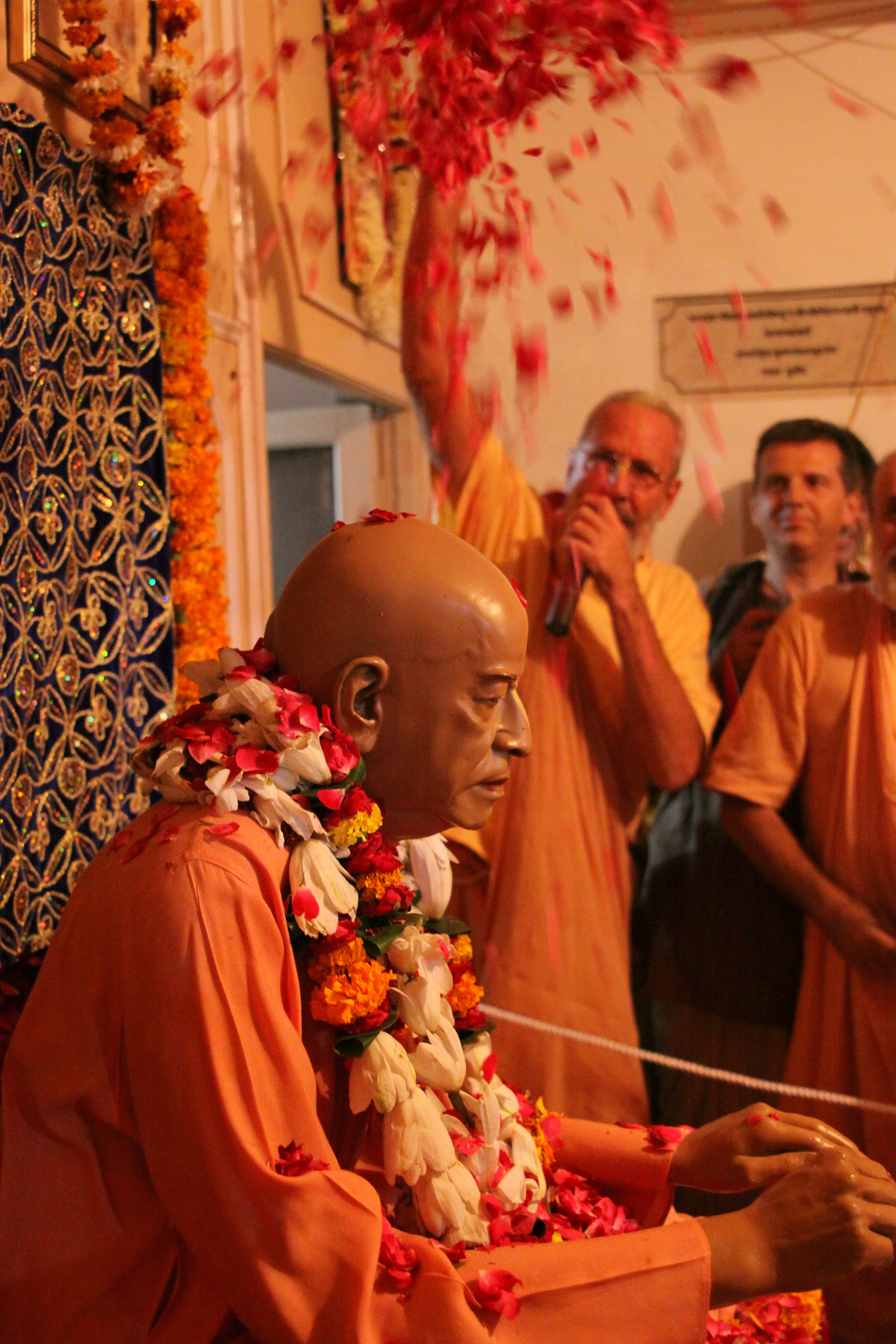The words of the sādhus, imbued with the transcendental purity of Kṛṣṇa consciousness, bring soothing relief to those scorched by the blazing fire of material existence. They are spoken and shared without any ulterior motive, solely for the welfare of all living beings. The nature of the absolute truth is not only recorded in great literatures like the Bhagavad Gīta, Śrīmad Bhāgavatam and Śrī Caitanya Caritamṛta, but also dynamically revealed in disciplic succession in the hearts of the sādhus, affording a deeper understanding. It is essential to cultivate a desire to hear from the sādhus, offer service and submissively ask questions for one’s spiritual progress knowing that Kṛṣṇa is actively present within their hearts. If not for the sādhus, Kṛṣṇa largely remains unknowable and unreachable to anyone.

Personal association of the sādhu is extremely potent if our approach is sincere. The bhakta bhāgavata embodies the principles expounded in the grantha bhāgavata. In Caitanya Caritāmṛta, it is said, lava-mātra sādhu-saṅge sarva-siddhi haya — “The verdict of all revealed scriptures is that by even a moment’s association with a pure devotee, one can attain all success.” This is not a metaphorical statement. By the mercy of the sādhus, it is possible to instantly absorb their inner mood and character, which purifies our prior understanding putting it in proper perspective in relation to Kṛṣṇa. The devotional mood of the sādhu is a storehouse of perfect philosophical conclusions that anyone can benefit from, through surrender and service.
Hearing with attention, every piece of guidance and understanding received from the sādhu should be valued and respected. By neglecting or not following them, we lose clarity and focus in our spiritual life. Everything we learn from the sādhu ultimately has its fulfillment in our realization of those teachings. Realization actually means cultivating a vision of absolute reality, which is synonymous to cultivating Kṛṣṇa consciousness. A real vision helps us to see through stereotypes created by the mind. The dress code does not confirm a devotee, nor does the use of devotional jargons, gentle behaviour, or even scholarship. One may find humility in apparent arrogance, and arrogance under a veneer of humility. Realization is the depth of vision that allows us to see beyond the material facade into absolute reality.
Unfortunately, our attachment to form inhibits our eagerness for any real advancement in terms of realizations. When Śrīla Śrīdhar Mahārāja declared that he is a form breaker and upheld the predominance of ideals over institutional unity, the form lovers could not appreciate it. They sought refuge in their collective ignorance, instead of embracing the vaiṣṇava ideals in its entirety. Superficial understanding of Kṛṣṇa consciousness becomes a breeding ground for misconceptions and worse—vaiṣṇava aparādha. One is better off being completely ignorant than risk a position founded on half-baked ideas.
In the association of great devotees, one may be fortunate to hear high realizations flowing from their hearts. Those high realizations add to the wealth of our saṃpradāya. Particular care and reverence should be shown when approaching the contributions of our ācāryas, so that we may not overstep our adhikāra. Moreover, those contributions are not to be treated as mere knowledge to augment our scholarship. In the early days of our mission, our Śrīla Guru Mahārāja chose to dissociate from a certain well-known sannyāsī after a particular exchange in conversation. Although there were other reasons, but during that interaction, the sannyāsī displayed a rather dismissive attitude towards Śrīla Śrīdhara Mahārāja’s profound revelation of rādhā-dāsyam as the highest understanding of the brahma-gāyatrī mantra, brushing it aside with a casual remark, “Oh, that is also found elsewhere.” Not only was the remark disrespectful towards Śrīla Śrīdhar Mahārāja’s position, it was factually incorrect, and seemed to reduce a valuable contribution to just another piece of information.
Śrīla Śrīdhar Mahārāja’s recorded informal talks are a treasure of deliberations on various tattvas that illuminate numerous philosophical points in rich detail. Just as a fine-grit sander brings out the shine on a rough surface, his words have brought much clarity and depth to our understanding of all vaiṣṇava conceptions. Appreciation is natural, but our understanding must ultimately manifest in our service attitude and dedication.
A sannyāsi of a big mission outside of Śrīla Śrīdhara Mahāraja’s maṭh once said that he also ‘takes’ from Śridhar Mahāraja for his lectures. When our Guru Mahārāja heard this, he remarked, “We don’t just take from Śrīdhara Mahārāja—we serve his conceptions. There is a big difference.” Our Guru Mahārāja did not create a Śrīdhar Mahārāja fan club to pay lip service to his teachings. He was hands-on, committed, ready to make any sacrifice, accepting all inconveniences to move closer to the ideals found in the teachings of Śrīla Śrīdhar Mahārāja, and all our ācāryas. This alone is the path through which one can truly relish and meaningfully share the teachings.
We must have a general understanding of who is a vaiṣṇava sādhu, but a particular understanding of the mood of our Guru and the guru-paraṃpara. Our very identity depends upon it. On His way to Vṛndāvana, Śrī Caitanya Mahāprabhu passed through Mathura where He met a sānoḍiyā brāhmaṇa. By observing the ecstatic love of Śrī Caitanya Mahāprabhu, the elderly brāhmaṇa could immediately recognize the Lord’s connection to the line of Śrī Mādhavendra Puri and spoke the following—
kintu tomāra prema dekhi' mane anumāni
mādhavendra-purīra 'sambandha' dhara--jāni
kṛṣṇa-premā tāṅhā, yāṅhā tāṅhāra'sambandha'
tāhāṅ vinā ei premāra kāhāṅ nāhi gandha
Upon seeing Your ecstatic love, I can just imagine that You must have some relationship with Mādhavendra Purī. This is my understanding. This kind of ecstatic love can be experienced only when one has a relationship with Mādhavendra Purī. Without him, even a scent of such transcendental ecstatic love is impossible. (CC Madhya 17.172-173)
The sānoḍiyā brāhṃaṇa could detect the mood of his guru Śrī Mādhavendra Puri in Śrī Caitanya Mahāprabhu. There is a distinct characteristic unique to our paramparā, and in the modern revival of Mahāprabhu’s line, Śrīla Bhaktisiddhānta Sarasvatī Ṭhākura Prabhupāda traced it out while marking the disciplic succession. One can exhaustively know about guru-tattva and the unique characteristic of our line in Śrīla Śrīdhar Mahārāja’s excellent book, Śrī Guru & His Grace.
 Our Guru Mahārāja was personally graced by Śrīla A.C. Bhaktivedanta Swami Prabhupāda, Śrīla B.R. Śrīdhara Mahārāja, and Śrīla B.P. Puri Mahārāja. There was absolutely no trace of doubt in him that serving one was in any way separate from serving the others. He clearly recognized the mood of the Caitanya-Sāraswata line harmoniously flowing through all of them and strongly rejected any suggestion to the contrary as a discordant note, especially when neophyte devotees questioned his simultaneous affiliation with these great personalities. On several occasions, while discussing and glorifying the Gāyatrī Nigūḍhārtha commentary by Śrīla Śrīdhara Mahārāja, our Guru Mahārāja would emphatically point to its praise by Śrīla Puri Mahārāja, highlighting that Purī Mahārāja's glorification in itself is most glorious. Instances like these offered powerful, practical insights into the deeper understanding of the all-important guru-tattva.
Our Guru Mahārāja was personally graced by Śrīla A.C. Bhaktivedanta Swami Prabhupāda, Śrīla B.R. Śrīdhara Mahārāja, and Śrīla B.P. Puri Mahārāja. There was absolutely no trace of doubt in him that serving one was in any way separate from serving the others. He clearly recognized the mood of the Caitanya-Sāraswata line harmoniously flowing through all of them and strongly rejected any suggestion to the contrary as a discordant note, especially when neophyte devotees questioned his simultaneous affiliation with these great personalities. On several occasions, while discussing and glorifying the Gāyatrī Nigūḍhārtha commentary by Śrīla Śrīdhara Mahārāja, our Guru Mahārāja would emphatically point to its praise by Śrīla Puri Mahārāja, highlighting that Purī Mahārāja's glorification in itself is most glorious. Instances like these offered powerful, practical insights into the deeper understanding of the all-important guru-tattva.
Within the nature and interactions between the great devotees, one can observe Vaiṣṇava ideals and standards being naturally enacted for the benefit of all who wish to progress swiftly on the path of devotion. Such standards are descending in nature—they cannot be manufactured through śāstric research of independent scholars and handed down as official decrees. The real standards are the principles of the bhāgavata dharma which are originally enacted by the Supreme Lord Himself (dharmam tu sākśāt bhagavat praṇītam). That very dharma manifests within the hearts of great devotees (adbhuta-krama parāyaṇa), and by closely following and learning from their nature (śīla-śikṣa), even the beastly (tiryak-janāḥ) can benefit, what to speak of learned devotees (śruta-dhāraṇāḥ).
To remain within the physical confines of our estimation of the guru and the guru-parampara is certainly a serious handicap. On the other hand, to forgo all physical considerations at whim, like in the ṛtvik system, is making a mockery of the whole process. Standards guide us. To be liberal and broadminded is an admirable Vaiṣṇava quality, but having no standards at all is self-destructive in nature. In order to make real progress one must recognize and come to the right understanding of the standards set by our previous ācāryas.
